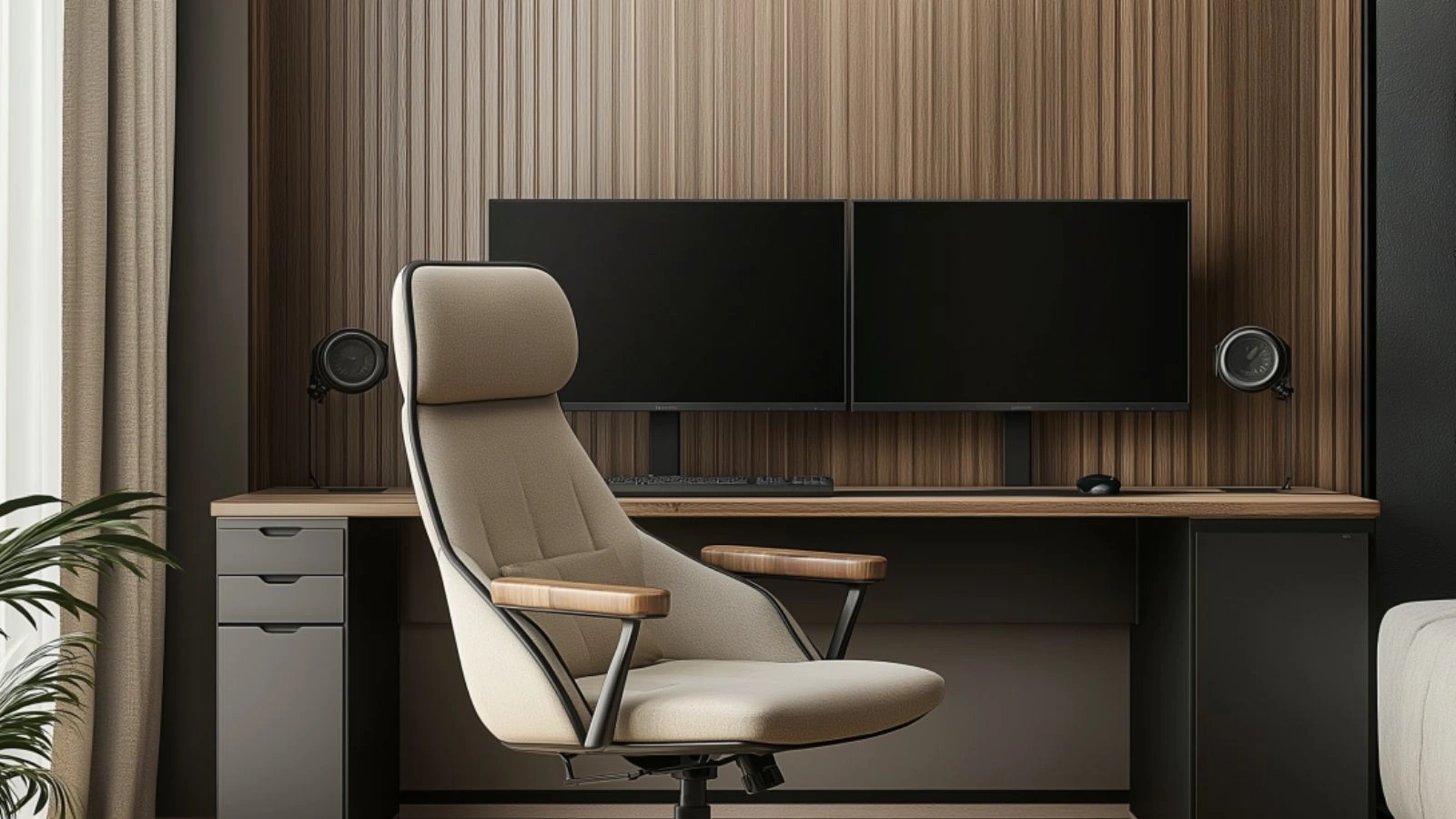Work From Home Set Up with Dual Monitors: Maximize Efficiency and Comfort in Your Living Room
Table of Contents
The shift toward remote work has changed the way we design our homes. With more people working from home full-time, the need for a functional yet aesthetically pleasing workspace is greater than ever. According to a 2023 survey by FlexJobs, 65% of remote workers said they’re more productive at home—but only when their workspace is properly set up. One of the biggest game-changers? A dual monitor setup.
A work-from-home set up with dual monitors not only boosts productivity but also makes multitasking, creative work, and communication smoother and faster. And when your home office is set up in your living room—a space that needs to maintain both beauty and function—every detail matters.
In this post, we’ll explore how to build a dual monitor workstation that fits seamlessly into your living room. From choosing the right desk and managing cables to creating ergonomic comfort and maintaining your home’s aesthetic, these practical ideas will help you maximize both efficiency and design harmony.
Start with the Right Desk That Fits Your Living Room
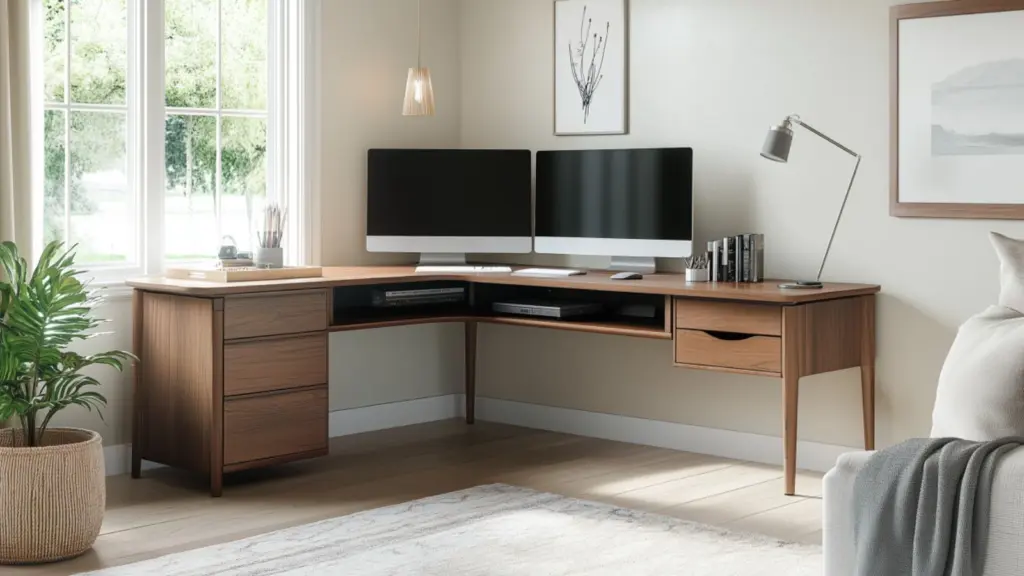
The foundation of any good work-from-home setup is the desk, and choosing the right one for a living room environment is a delicate balance of size, style, and functionality. Unlike a traditional office, your living room is likely a shared or open space—so your desk needs to be visually cohesive with your home décor.
Consider desks that offer enough surface area to accommodate two monitors without dominating the room. A sleek writing desk, corner unit, or wall-mounted floating desk can work wonders. Look for built-in cable ports, drawers for storage, and finishes that match your furniture or flooring.
Desk Selection Guide
| Desk Type | Best For | Style Integration Tip |
|---|---|---|
| Corner Desk | Maximize unused space | Choose a wood tone that blends in |
| Compact Executive Desk | Larger surface area with storage | Select minimal hardware |
| Floating Wall Desk | Save floor space in small rooms | Mount at eye level for dual screens |
| Standing Desk | Improve posture and versatility | Hide cables with built-in panels |
Choosing a desk that fits both your tech and your living room style ensures your setup enhances—not interrupts—your home aesthetic.
Position Dual Monitors for Comfort and Functionality
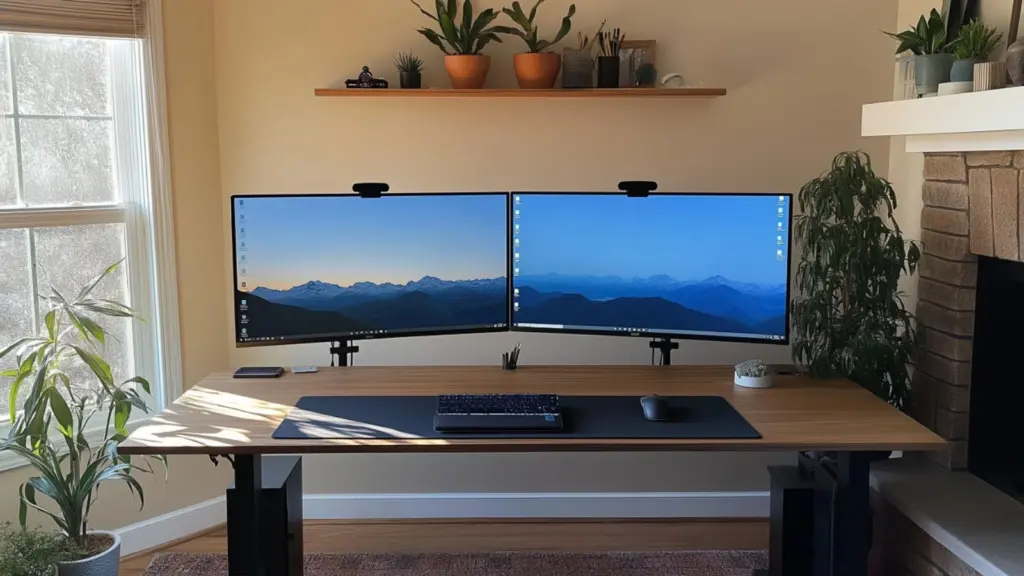
Once your desk is in place, the next priority is monitor placement. The beauty of dual monitors lies in their ability to streamline workflow—but poor positioning can lead to neck strain, poor posture, and visual fatigue.
Monitors should sit at eye level and about an arm’s length away. The ideal setup places the primary monitor directly in front of you and the secondary either to the side at a slight angle or above the primary screen if space is tight. If you split tasks evenly across both screens, keep them centered.
Use adjustable monitor arms to raise, tilt, and rotate your displays to suit your working habits. These also free up desk space and make it easier to tidy cables. For a living room setup, opt for sleek, low-profile arms that blend into the background.
Monitor Placement Tips
| Setup Style | Best For | Ergonomic Benefit |
|---|---|---|
| Side-by-Side Even | Equal use of both screens | Balanced posture and motion |
| Primary + Angled Side | Main work on one, reference on second | Focus on primary screen |
| Stacked Configuration | Limited desk space | Reduces width, ideal for corner desks |
| Adjustable Arms | Maximum flexibility | Customize height and rotation |
Comfortable screen positioning enhances productivity and helps you maintain energy throughout the day.
Choose an Ergonomic Chair That Complements Your Decor
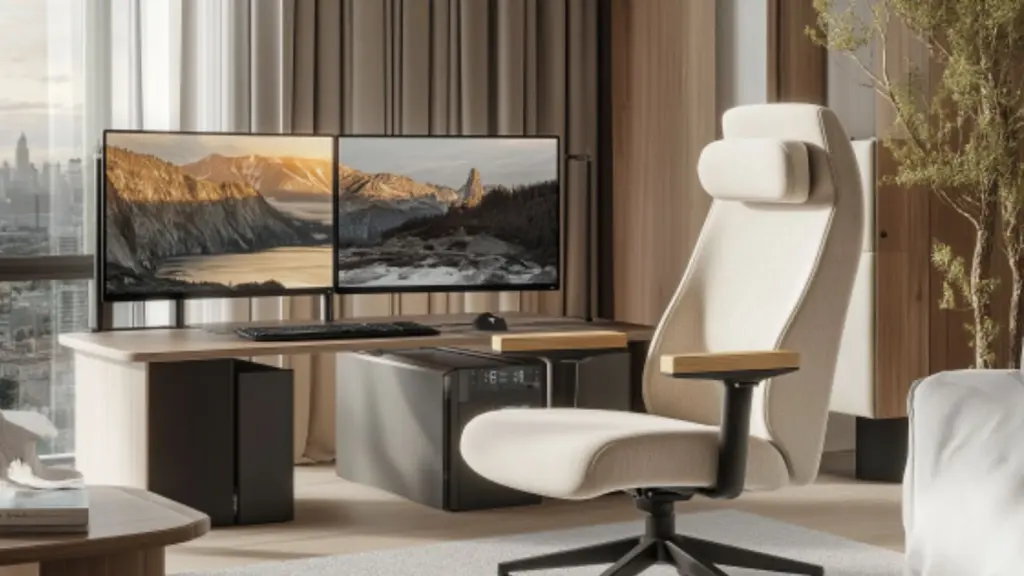
Working from your living room doesn’t mean compromising on back support. Investing in an ergonomic chair is essential—but in a shared space, looks matter just as much as function.
Opt for chairs that offer adjustable height, lumbar support, and padded arms. Many modern task chairs come in upholstery fabrics, wood accents, or muted tones that blend well with living room decor. If space is tight, consider armless options or chairs that can tuck neatly under your desk when not in use.
If you already have an accent chair or side chair in place, a supportive seat cushion and lumbar pillow can offer a temporary ergonomic boost—though it’s best to invest in a purpose-built chair if you work long hours.
Ergonomic Chair Guide
| Feature | Why It Matters | Living Room-Friendly Style Tip |
|---|---|---|
| Lumbar Support | Reduces back strain | Choose built-in or pillow support |
| Adjustable Height | Aligns with desk and monitor height | Stick to neutral or textured fabric |
| Padded Armrests | Prevents shoulder tension | Look for wood or brass detailing |
| Swivel Base | Adds mobility and flexibility | Choose matte black or chrome base |
Comfortable seating makes a major difference in long-term productivity and wellness.
Manage Cables and Clutter with Concealed Storage
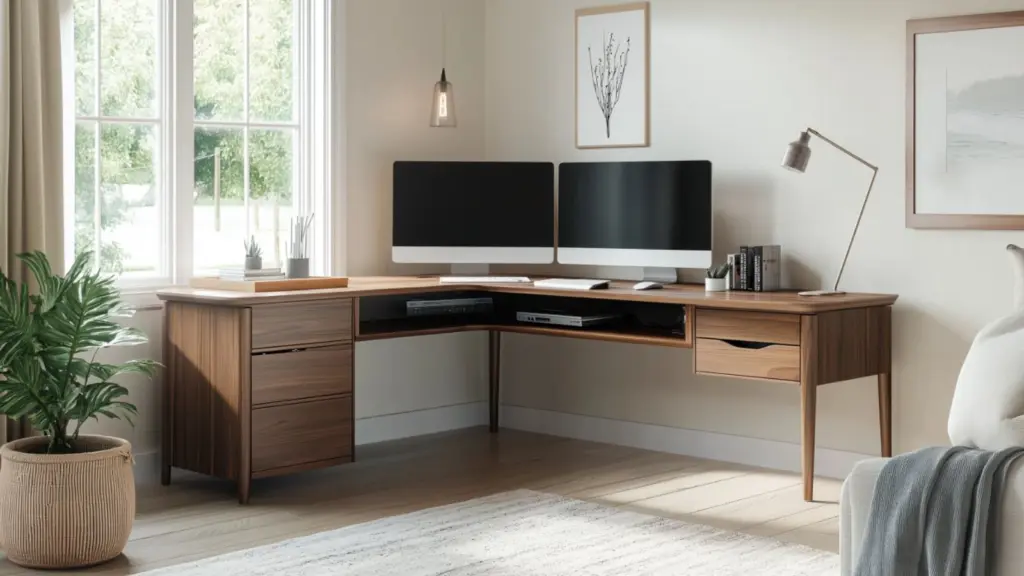
Nothing disrupts the tranquility of a living room like a mess of cords and office clutter. A tidy setup not only looks better—it also helps you stay focused and organized.
Start by using cable sleeves, clips, or boxes to bundle and hide wires. Run cords along the underside of your desk or baseboards to keep them out of sight. Power strips with USB ports can centralize your devices and reduce visible tangle.
For storage, use woven baskets, fabric bins, or drawers to hold extra cables, chargers, and office supplies. Consider a small filing cabinet that doubles as a side table or a built-in unit with doors to disguise tech gear.
Cable and Clutter Control Checklist
| Solution | Function | Aesthetic Tip |
|---|---|---|
| Cable Sleeves or Boxes | Hide unsightly wires | Choose colors that match your decor |
| Under-Desk Clips or Trays | Secure cords under surfaces | Keep floor area clean and open |
| Decorative Bins or Baskets | Store extra gear and chargers | Match with rug or throw textures |
| Dual-Purpose Furniture | Storage + side table or console | Choose closed shelving |
A well-managed workspace blends seamlessly with the rest of the room while still supporting all your tech needs.
Use Lighting to Boost Mood and Minimize Eye Strain
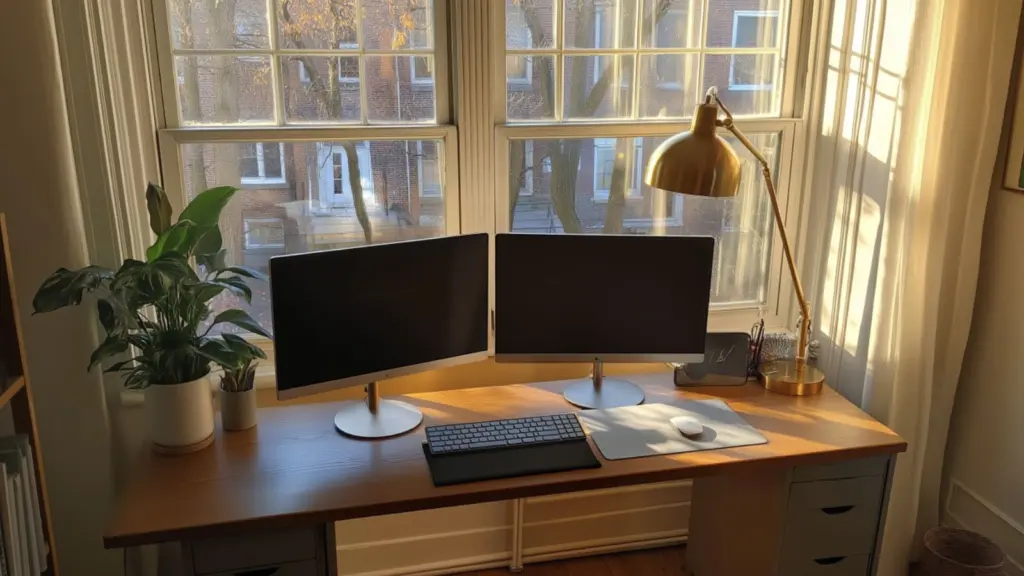
Lighting is one of the most overlooked—but critical—parts of a dual monitor work-from-home setup. Natural light is ideal for energy and mental clarity, but harsh glares or dim spaces can quickly lead to discomfort.
Position your desk perpendicular to windows to avoid reflections on screens. Use layered lighting: task lamps for focused work, ambient lights for overall illumination, and accent lighting to soften the mood.
Opt for adjustable desk lamps with color temperature control—warmer light for evenings and cooler tones for focused tasks. Avoid overhead lights that cast harsh shadows on screens. Floor lamps behind your desk or smart bulbs in decorative sconces add flexibility and a design-forward look.
Workspace Lighting Strategy
| Light Type | Role in Setup | Style Enhancement Tip |
|---|---|---|
| Task Lamp | Focused light on workspace | Matte brass or ceramic finishes |
| Ambient Ceiling Light | General illumination | Dimmer controls or smart bulbs |
| Accent or Floor Lamp | Fills in corners, sets mood | Natural textures, linen shades |
| Screen Lighting Bar | Reduces screen glare at night | Minimalist or low-profile design |
Balanced lighting improves eye comfort and keeps your work zone inviting throughout the day.
Maintain Visual Harmony with Cohesive Styling
One of the biggest challenges of setting up an office in your living room is maintaining a cohesive design aesthetic. Your work zone should feel integrated, not like an afterthought. Use materials, colors, and finishes that match or complement your existing furniture.
Stick to a consistent color palette—whether it’s black and walnut, white and oak, or soft grays with brass. Choose desk accessories like pen holders, trays, or document stands that echo the style of your living room décor. Add personal touches like framed art, plants, or a decorative clock that tie the space together visually.
Styling Harmony Guide
| Styling Element | Adds to Cohesion | Living Room Integration Idea |
|---|---|---|
| Color Palette | Keeps space feeling unified | Match accessories to throw pillows |
| Material Consistency | Adds visual flow | Echo finishes from coffee table |
| Artwork or Prints | Makes space feel intentional | Align with nearby gallery wall |
| Greenery or Florals | Softens tech-heavy setups | Use same planters across room |
With intentional styling, your workspace feels like a natural extension of your home.
Conclusion
Creating a work-from-home setup with dual monitors in your living room requires more than just technical equipment—it’s about designing a space that enhances productivity while respecting the flow and aesthetic of your home. With the right desk, monitor positioning, ergonomic chair, clutter management, and styling, you can create a workspace that feels both efficient and effortlessly integrated.
When function meets design, your living room becomes more than a lounging space—it becomes the hub of your professional creativity and focus.

